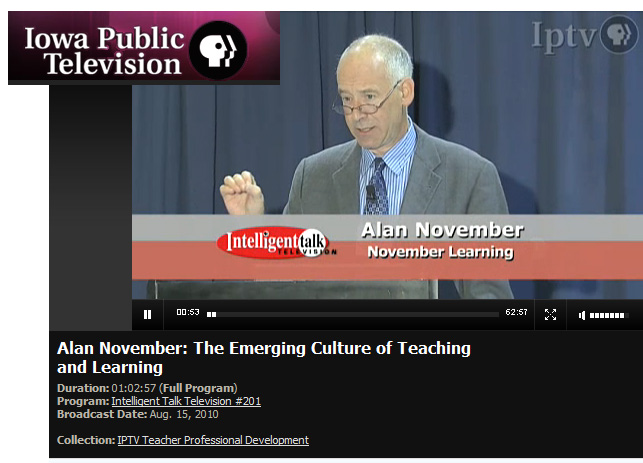The Fisch Flip in Michigan: Dale Eizenga on flipping traditional lecture and homework routines — from singaporeeducationdirectory.com
Excerpt:
Today I had the opportunity to spend time visiting with teachers and students at Holland Christian Schools in Holland, Michigan. One highlight of my day was the following five minutes of sharing by Holland Christian Schools’ chemistry teacher Dale Eizenga. Dale explained how access to a variety of technology resources has enabled him to flip the traditional in-class lecture and at-home assignment model of learning. Using software and websites, Dale records many lessons for students and makes those screencast videos available online and via the school’s podcast channel.
Several things are notable here. First, Dale didn’t read about Jonathan Bergmann and Aaron Sams, or Karl Fisch, online or in print. He stumbled upon this instructional model when his school provided all teachers and students with a robust digital learning environment. That not only includes access to laptops (for everyone in grades 6-12) but also an online learning management system (Moodle,) robust digital curriculum resources, school-supported options for sharing videos online, AND certified educators supporting technology integration. There are a lot of ingredients to this situation, and that’s critical to understand.
Secondly, Dale addresses in the video how some students struggle with this SHIFT to a “lecture at home on video” model. Dale still shares some lectures in class with students. He mixes it up. Dale explains this model forces students to “own their learning” in ways they may not have needed to in a traditional lecture-in-class setting. Dale relates this as “more of a college model,” where students are responsible for THEIR OWN learning. Dale explains his instructional role as one where he surrounds students with learning resources, and then assists students as they access / utilize those resources. When students aren’t “getting it,” he’s able to talk with them to find out if they’ve watched the podcast video which applies to the current topic or skill, and find out what students need specifically to master new content.
From DSC:
The folks at Holland Christian are doing an awesome job! Keep up the great work over there!
.

The Backwards Class — from The Journal
A fairly new teacher has come up with a way to help her anxiety-ridden AP Calculus students relax more in class. She’s using an approach dubbed by her students as the “backwards classroom.” Results have been remarkable. She credits the method of an increase in test scores and says the teaching style suits motivated students…
What’s the approach?
The students watch pre-recorded lectures the night before the class, when homework problems are traditionally done, then spend the time in class getting answers to questions, working on additional problems with partners, and getting one-on-one assistance from the teacher. No more lectures in class.
.
Also see:
- Teachers turn learning upside down — from Meris Stansbury
‘Inverted learning’ allows students to practice what they learn under the guidance of their classroom teacher
“The main idea behind the ‘flipped’ classroom is for teachers to be available when students need them most. If I lecture for 30 minutes … in my chemistry classes, that would leave me about 20 minutes to assign homework and let students start on it,” he explained.
…
Spencer began to create screencasts of his lectures using Camtasia the day before. Those screencasts then became the homework—and class time was for doing “homework,” or answering questions and doing labs/demos.
…
“Many students are good at ‘playing school’ and going through the motions. Now that they have to demonstrate what they learn before moving on, some of them get quite upset when they scribble down a page of notes from a screencast without thinking about it and then are asked to redo it when it becomes obvious that they are just trying to work the system. Another complaint I have heard [from parents] is that ‘I’m not teaching them anything.’ Many students and parents expect the teacher to be the ‘sage on the stage’ and not a voice on an iPod.”
…
“My greatest challenge is time. It does take time to set this up and build in the flexibility to meet the students’ needs. Unfortunately, there isn’t a lot of compensation for extra hours invested, but for me, the investment in our future is worth it.”
His advice to other teachers and schools looking to implement this learning is to “start slow—one or two vodcasts a month is plenty to whet your students’ appetites. Build libraries collaboratively, and don’t be afraid to make a mistake. It is through experimentation and modification that we hone our art of teaching.”
Flipping the Economics Class — from Powerful Learning Practice
Nothing is Off the Table — from The Future of Education by Jesse Moyer
Excerpt re: Inverted Learning
Inverted learning involves students accessing and listening to teachers’ lectures outside of the classroom, think homework, and using the time in the classroom to apply those lessons. Teachers quoted in the eSchool News article entitled “Teachers Turn Learning Upside Down,” believe this new style of instruction allows students to focus on the class, not the teacher, while in the classroom. Says one forward thinking educator, “Students can absorb the material as homework and then practice what they’ve learned with guided help from the teacher if they need it. This new learning style not only makes class time more productive for both teachers and students, but also increases student engagement, increases achievement, and caters to all forms of personalized learning.”
From DSC:
This “flips” the lecture/lesson to outside the classroom, and moves the homework and other types of activities to the classroom setting where one can instantly get help if one needs it.










